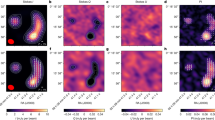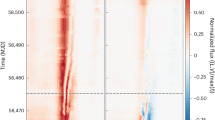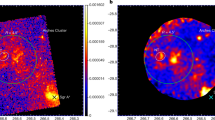Abstract
Magnetic fields play a key role in most astrophysical systems, from the Sun to active galactic nuclei1,2,3. They can be studied through their effects on atomic energy levels, which produce polarized spectral lines4,5. In particular, anisotropic radiation ‘pumping’ processes6,7 (which send electrons to higher atomic levels) induce population imbalances that are modified by weak magnetic fields8,9. Here we report peculiarly polarized light in the He I 10,830-Å multiplet observed in a coronal filament located at the centre of the solar disk. We show that the polarized light arises from selective absorption from the ground level of the triplet system of helium, and that it implies the presence of magnetic fields of the order of a few gauss that are highly inclined with respect to the solar radius vector. This disproves the common belief4,10,11 that population imbalances in long-lived atomic levels are insignificant in the presence of inclined fields of the order of a few gauss, and opens up a new diagnostic window for the investigation of solar magnetic fields.
This is a preview of subscription content, access via your institution
Access options
Subscribe to this journal
Receive 51 print issues and online access
$199.00 per year
only $3.90 per issue
Buy this article
- Purchase on Springer Link
- Instant access to full article PDF
Prices may be subject to local taxes which are calculated during checkout




Similar content being viewed by others
References
Parker, E. N. Cosmical Magnetic Fields (Clarendon, Oxford, 1979).
Schrijver, C. J. & Zwaan, C. Solar and Stellar Magnetic Activity (Cambridge Univ. Press, Cambridge, 2000).
Blandford, R. et al. in Astrophysical Spectropolarimetry (eds Trujillo Bueno, J., Moreno-Insertis, F. & Sánchez, F.) 177–223 (Cambridge Univ. Press, Cambridge, 2002).
Stenflo, J. O. Solar Magnetic Fields: Polarized Radiation Diagnostics (Kluwer, Dordrecht, 1994).
Landi Degl'Innocenti, E. in Astrophysical Spectropolarimetry (eds Trujillo Bueno, J., Moreno-Insertis, F. & Sánchez, F.) 1–53 (Cambridge Univ. Press, Cambridge, 2002).
Cohen-Tannoudji, C. & Kastler, A. Optical pumping. Prog. Opt. 5, 3–81 (1966).
Happer, W. Optical pumping. Rev. Mod. Phys. 44, 169–249 (1972).
Hanle, W. Über magnetische Beeinflussung der Polarisation der Resonanzfluoreszenz. Z. Phys. 30, 93–105 (1924).
Trujillo Bueno, J. in Advanced Solar Polarimetry: Theory, Observations and Instrumentation (ed. Sigwarth, M.) 161–195 (ASP Conf. Series, Astronomical Society of the Pacific, San Francisco, 2001).
Stenflo, J. O. Quantum interferences, hyperfine structure, and Raman scattering on the Sun. Astron. Astrophys. 324, 344–356 (1997).
Stenflo, J. O. in Advanced Solar Polarimetry: Theory, Observations and Instrumentation (ed. Sigwarth, M.) 97–108 (ASP Conf. Series, Astronomical Society of the Pacific, San Francisco, 2001).
Condon, E. U. & Shortley, G. H. The Theory of Atomic Spectra (Cambridge Univ. Press, Cambridge, 1979).
Stenflo, J. O. & Keller, C. The second solar spectrum: a new window for diagnostics of the Sun. Astron. Astrophys. 321, 927–934 (1997).
Lin, H., Penn, M. J. & Kuhn, J. R. He I 10830 line polarimetry: A new tool to probe the filament magnetic fields. Astrophys. J. 493, 978–995 (1998).
Stenflo, J. O., Keller, C. & Gandorfer, A. Anomalous polarization effects due to coherent scattering on the sun. Astron. Astrophys. 355, 789–804 (2000).
Landi Degl'Innocenti, E. Evidence against turbulent and canopy-like magnetic fields in the solar chromosphere. Nature 392, 256–258 (1998).
Trujillo Bueno, J. in Solar Polarization (eds Nagendra, K. N. & Stenflo, J. O.) 73–96 (Kluwer Academic, Dordrecht, 1999).
van Ballegooijen, A. A. Solar prominence models. In Encyclopedia of Astronomy and Astrophysics (ed. Murdin, P.) 2703–2707 (Nature Publishing Group, London, 2001); also at 〈http://www.ency-astro.com〉 (2001).
Faurobert-Scholl, M. Hanle effect with partial frequency redistribution. I. Numerical methods and first applications. Astron. Astrophys. 246, 469–480 (1991).
Trujillo Bueno, J. & Landi Degl'Innocenti, E. Linear polarization due to lower-level depopulation pumping in stellar atmospheres. Astrophys. J. 482, L183–L186 (1997).
Martínez Pillet, V. et al. in High Resolution Solar Physics: Theory, Observations, and Techniques (eds Rimmele, T. R., Balasubramaniam, K. S. & Radick, R. R.) 264–272 (ASP Conf. Series 183, Astronomical Society of the Pacific, San Francisco, 1999).
Soltau, D. in The Role of Fine-Scale Magnetic Fields on the Structure of the Solar Atmosphere (eds Schröter, E. H., Vázquez, M. & Wyller, A. A.) 362–366 (Cambridge Univ. Press, Cambridge, 1987).
Radzig, A. A. & Smirnov, B. M. Reference Data on Atoms, Molecules, and Ions (Springer, Berlin, 1985).
Landolfi, M. & Landi Degl'Innocenti, E. Resonance scattering and the diagnostic of very weak magnetic fields in diffuse media. Astron. Astrophys. 167, 200–206 (1986).
Landi Degl'Innocenti, E. The determination of vector magnetic fields in prominences from the observations of the Stokes profiles in the D3 line of helium. Solar Phys. 79, 291–322 (1982).
Landi Degl'Innocenti, E. Polarization in spectral lines: I. A unifying theoretical approach. Solar Phys. 85, 3–31 (1983).
Bommier, V. Quantum theory of the Hanle effect. Astron. Astrophys. 87, 109–120 (1980).
Chandrasekhar, S. Radiative Transfer (Dover, New York, 1960).
Acknowledgements
We thank R. Casini and J. O. Stenflo for discussions on quantum electrodynamics and for helping with the presentation of this Letter. The German Vacuum Tower Telescope is operated by the Kiepenheuer Institut at the Observatorio del Teide of the Instituto de Astrofísica de Canarias (IAC). The Tenerife Infrared Polarimeter has been developed by the IAC. We also acknowledge the support of the European Solar Magnetometry Network and of the Spanish Plan Nacional de Astronomía y Astrofísica.
Author information
Authors and Affiliations
Corresponding author
Rights and permissions
About this article
Cite this article
Trujillo Bueno, J., Landi Degl'Innocenti, E., Collados, M. et al. Selective absorption processes as the origin of puzzling spectral line polarization from the Sun. Nature 415, 403–406 (2002). https://doi.org/10.1038/415403a
Received:
Accepted:
Issue Date:
DOI: https://doi.org/10.1038/415403a
This article is cited by
-
Magnetic imaging of the outer solar atmosphere (MImOSA)
Experimental Astronomy (2022)
-
Ultraviolet spectropolarimetry: investigating stellar magnetic field diagnostics
Astrophysics and Space Science (2022)
-
Quiet Sun magnetic fields: an observational view
Living Reviews in Solar Physics (2019)
-
Measurements of Photospheric and Chromospheric Magnetic Fields
Space Science Reviews (2017)
-
The Physics and Diagnostic Potential of Ultraviolet Spectropolarimetry
Space Science Reviews (2017)
Comments
By submitting a comment you agree to abide by our Terms and Community Guidelines. If you find something abusive or that does not comply with our terms or guidelines please flag it as inappropriate.



